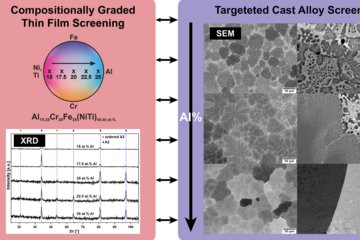All genres
61.
Journal Article
Experimental Study of the Fe–Ni–Ti System. Intermetallics 18 (3), pp. 374 - 384 (2010)
62.
Journal Article
Thermodynamic Assessment of the Cr–Al–Nb System. International Journal of Materials Research 101 (11), pp. 1369 - 1375 (2010)
63.
Journal Article
Determination of the crystal structure of the ε phase in the Fe–Al system by high-temperature neutron diffraction. Intermetallics 18 (1), pp. 150 - 156 (2010)
64.
Journal Article
Creep Strength of a Binary Al62Ti38 Alloy. International Journal of Materials Research 101 (5), pp. 676 - 679 (2010)
65.
Journal Article
High Temperature Creep Behaviour of Al-rich TiAl Alloys. Journal of Physics: Conference Series 240, 012084 (2010)
66.
Journal Article
The Ternary System Nickel-Silicon-Titanium Revisited. Zeitschrift für Anorganische und Allgemeine Chemie 636 (6), pp. 982 - 990 (2010)
67.
Journal Article
Creep strength of centrifugally cast Al-rich TiAl alloys. Materials Science and Engineering A: Structural Materials Properties Microstructure and Processing 510-511 (C), pp. 373 - 376 (2009)
68.
Journal Article
Unusual mechanical behaviour of the intermetallic phase Nb2Co7. Materials Science and Engineering A: Structural Materials Properties Microstructure and Processing 497, pp. 174 - 180 (2008)
69.
Journal Article
Experimental reinvestigation of the Co–Nb phase diagram. Intermetallics 16 (6), pp. 785 - 792 (2008)
70.
Journal Article
On the reaction scheme and liquidus surface in the ternary system Fe–Si–Ti. Intermetallics 16 (2), pp. 273 - 282 (2008)
71.
Journal Article
Characterization of the microstructure of Al-rich TiAl alloys by combined TEM imaging techniques. Microscopy and Microanalysis 13 (3), pp. 294 - 295 (2007)
72.
Journal Article
Re-determination of transition temperatures in the Fe–Al system by differential thermal analysis. International Journal of Materials Research 98 (7), pp. 580 - 588 (2007)
73.
Journal Article
Preparation, phase stability and structure of the C36 Laves phase Nb1-xCo2+x. Zeitschrift für Kristallographie 221(5), pp. 319 - 333 (2006)
74.
Journal Article
Mechanical Properties and Oxidation Behaviour of Two-Phase Iron Aluminium Alloys with Zr(Fe,Al)2 Laves Phase or Zr(Fe,Al)12 τ1 Phase. Intermetallics 13 (12), pp. 1275 - 1285 (2005)
75.
Journal Article
Early stages of protective layer growth on binary iron aluminides. Zeitschrift für physikalische Chemie 219, pp. 1489 - 1503 (2005)
76.
Journal Article
Study of Atom Diffusivity and Related Relaxation Phenomena in Fe3Al–(Ti,Nb)–C Alloys. Acta Materialia 53 (9), pp. 2581 - 2594 (2005)
77.
Journal Article
Dependence of the brittle-to-ductile transition temperature (BDTT) on the Al content of Fe–Al alloys. Intermetallics 13 (12), pp. 1337 - 1342 (2005)
78.
Journal Article
Structure and stability of Laves phases. Part II: Structure type variations in binary and ternary systems. Intermetallics 13 (10), pp. 1056 - 1074 (2005)
79.
Journal Article
Plastic deformation of Fe–Al polycrystals strengthened with Zr-containing Laves phases: Part II. Mechanical properties. Materials Science and Engineering A: Structural Materials Properties Microstructure and Processing 381 (1-2), pp. 1 - 15 (2004)
80.
Journal Article
Plastic Deformation of Fe–Al Polycrystals Strengthened with Zr-Containing Laves Phases: I. Microstructure of Undeformed Materials. Materials Science and Engineering A: Structural Materials Properties Microstructure and Processing 380 (1-2), pp. 9 - 19 (2004)











